How a gas stove works: operating principle and design of a typical gas stove
It’s hard to imagine modern life without kitchen appliances - with their help we cook dinner, bake pies, store food, and treat ourselves to fresh coffee in the morning. And among the numerous equipment, the stove stands out, which at one time successfully replaced the hearth - the stove.
The population of gasified areas, living in low-rise and private houses, uses gas stoves. If this tireless assistant has also settled in your kitchen, we suggest you figure out how a gas stove works, what parts it consists of and how to increase its service life.
Our tips will help you take care of your equipment and react correctly if it breaks down.
The content of the article:
Design and principle of operation of a gas stove
If you use cooking equipment every day, you know very well what parts it consists of and how it works.
In terms of their structure, all gas stoves are very similar, and the differences relate to design or design features associated with additional functions.
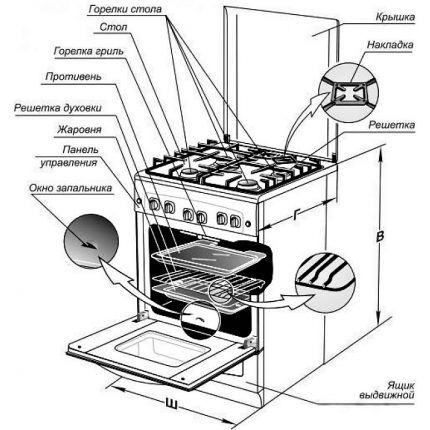
Modern manufacturers specializing in the manufacture of kitchen equipment are trying to diversify their model range by more conveniently positioning the burners and control panel, internal filling of the oven, and introducing electronic filling.
According to the place of installation, gas stoves are divided into floor And desktop. The latter are more often used as a summer cottage or temporary option. Also distinguished autonomous hobs, without an oven, which can be built into the countertop.
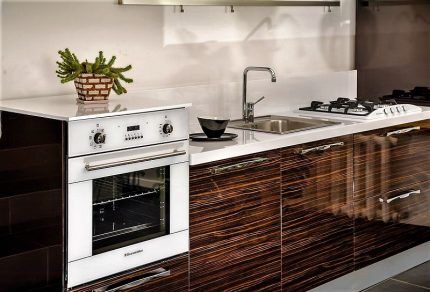
But you need to take into account that the simpler and more primitive the design of the slab, the easier it is to maintain. Inexpensive equipment, which is often purchased for installation in dachas, lasts a long time - it does not contain electronics, and parts that may break are always easy to replace.
Overview of the main elements of a gas stove:
In addition to the listed elements, more complex and expensive equipment has additional parts. This electric ignition unit And electronicsregulating the operation of the oven.
The latest models are produced with a pre-installed gas leak control system: if the flame accidentally goes out, the fuel supply is instantly shut off automatically.
Let's take a closer look at the elements directly involved in the workflow.
Hob structure
Nowadays no one calls the upper plane with the burners located on it a “table”; the name “stove” or “hob” is more often used when we are talking about built-in appliances. This is the element most often involved in the cooking process, and therefore requires regular care.

In inexpensive models, the upper plane, like the entire body, is covered with enamel. If it looks attractive on a new product, then in the future the appearance of the enamel deteriorates significantly: cracks and chips appear, making maintenance difficult.
A stainless steel stove also requires careful care. Matte or glossy surfaces do not like being rubbed with metal brushes.
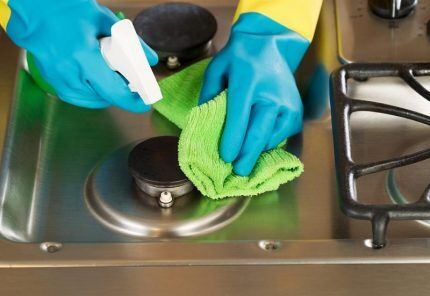
Abrasive products should absolutely not be used when caring for kitchen appliances.
Well, the main working elements on the hob are the burners, which can quickly fail if used incorrectly or poorly maintained.
How does a gas burner work?
In household appliances, multi-flame injection-type burners are used. The operating principle of any gas stove is based on the combustion process that occurs after mixing fuel with air.
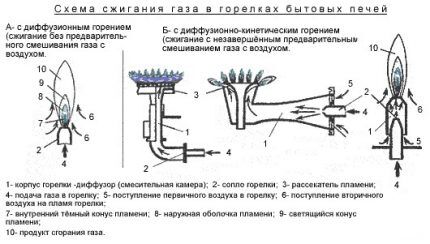
The design of the gas stove burner may differ, depending on the features of the models and the ability to adjust the flame, but the main parts are present in all products:
- nozzle, which controls gas flow at operating pressure parameters;
- diffuser (with or without a gate), in which the gas is mixed with primary air;
- frame – the chamber where the process of mixing gas with air ends.
The gas-air mixture is discharged into the combustion zone through holes located around the circumference of the upper edge of the burner.
The slotted fire holes are covered from above with a steel cover, which performs protective and distribution functions.
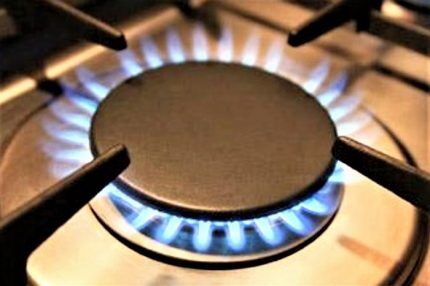
The general structure of the burners of household gas stoves designed to operate on propane-butane is slightly different from their analogues for natural gas.
Despite the strict rules for the production of gas stoves, the efficiency requirements are not so high - only 56%.
When burners with a pilot flame appeared, some elements of the burners were considered inappropriate - for example, the slide. Instead of a gate, two holes at the inlet end of the mixer are responsible for the injection of primary air.
Oven device
The oven is designed for baking dough products, roasting meat, fish, vegetables, etc. In design, it resembles an ordinary cabinet, but the shelves are made in the form of grates that do not interfere with the free circulation of heated air.
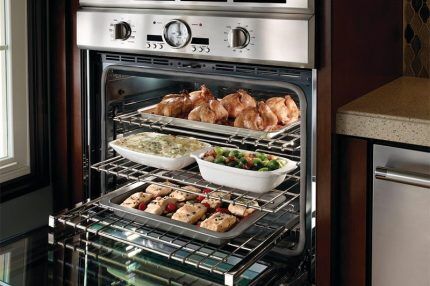
To maintain the necessary stable heating, it is equipped with a gas burner, which differs in design from hotplate burners.
The heating itself occurs due to circulating hot gases.
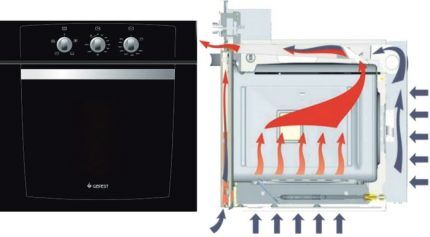
In modern models, one of the frying burners is located in the upper part of the cabinet, which helps bake food on all sides. The top position is also typical for ovens with a grill function.
Domestic stoves have disc-type burners with a pilot flame.

The main burner, which is usually ignited manually or automatically, is equipped with thermocouple And ignition tube. An emitter with a screen is installed on the frying top burner.
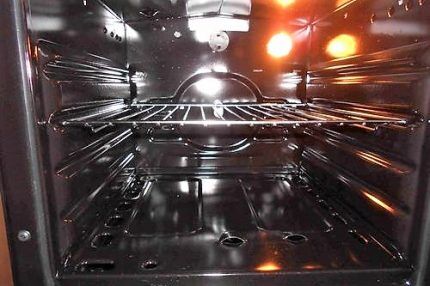
For your own benefit, we recommend that you learn more about the structure of a gas stove oven - this can be useful for minor independent repairs or choosing new equipment.
It must be remembered that the process of using the oven is accompanied by compliance with the rules. For example, you should not open the door while cooking - this sharply reduces the temperature and affects the baking process. You should not leave extra shelves or dishes in a working oven - this also negatively affects the result.
A typical stove design also assumes the presence of a drawer under the oven, the purpose of which can be found in this material.
Electrical control and monitoring system
The cheapest stoves do not have electronic control - the entire process is regulated mechanically. In more expensive models, an electrical system is connected to enable the functions electric ignition And lighting ovens, as well spit control.
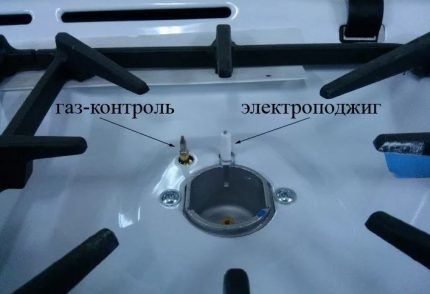
Some users are so accustomed to the auto-ignition system that they get lost when the power goes out and don’t know how to turn on the gas. This is done simply: the control knob must be placed in the working position, and then a lighted match must be quickly brought to the divider.
The backlight function works differently: in some ovens it turns on by pressing a button, in others it turns on automatically, every time the oven is turned on.
Gas control, which is operated by a thermocouple, is very useful.

The most expensive models are equipped with electronics, which facilitates both the cooking process and equipment maintenance.
Using a panel with buttons and a display, you can control all processes, which may include the following:
- timer;
- delayed start;
- steam oven cleaning;
- several cooking modes;
- light and acoustic alarm;
- electronic temperature control;
- rapid cooling system, etc.
If the stove is inexpensive, but equipped with electronics, you should ask yourself the question: how often will you have to contact the service center? Because, according to statistics, electronic equipment breaks down much more often than conventional equipment.
Criteria for choosing a stove
Let's consider the features of gas stoves, which do not relate to their technical characteristics, but relate exclusively to the design.
The design, content, and arrangement of elements are no less important than the power or number of operating modes.
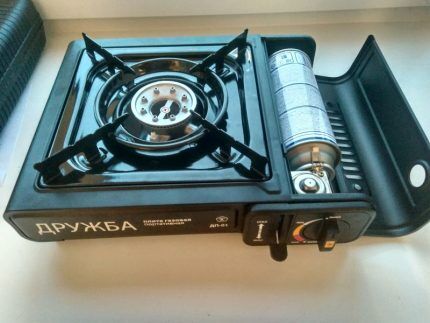
For continuous use, it is necessary to choose a reliable functional unit from a proven brand. To do this, you can read reviews and testimonials posted in large numbers on the Internet.
When purchasing from a design point of view, pay attention to criteria such as:
- dimensions of the stove in general and the hob in particular;
- oven volume;
- set of oven accessories;
- control panel location;
- location of the gas connection pipe;
- possibility of replacing burners for operation from bottled gas;
- number and sizes of burners.
Any unaccounted for detail may cause discomfort and dissatisfaction with the operation of the stove in the future, so try to think through everything in advance.
Rules of operation and repair
The serviceability of equipment and your personal safety largely depend on how you treat the equipment. This includes correct installation, careful operation, regular maintenance and replacement of parts that have a limited service life.
Here are the basic rules for using a gas stove:
- regularly clean the grill, stove surface, burners, control knobs;
- keep in touch with Gorgaz representatives and regularly carry out maintenance of equipment;
- ventilate the room, even if you use a hood;
- in case of prolonged absence, close the shut-off valve;
- Make sure that the knobs are in the “off” position while the hob is not in use.
You also need to be careful when using the oven. It, like any equipment, requires cleanliness and serviceability of all parts.
It is not recommended to use the oven as an ordinary cabinet for storing dishes, especially cluttering it with easily flammable or melting objects.
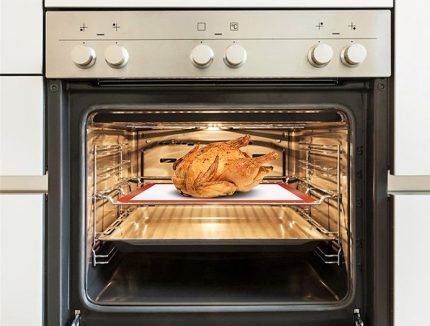
If the ventilation is faulty and it is not possible to open a vent or window, it is prohibited to use gas equipment.
If a specific smell of gas appears, it is necessary to open the fuel supply valve, open the windows and call the emergency service. During the waiting period, you should not turn on electrical appliances, light a flame, or better yet leave the room altogether. It is recommended to even make a call from the landing or from the street.
Repair of gas equipment should be carried out either by invited specialists from the service organization, or by employees of a specialized service center.
Conclusions and useful video on the topic
Useful tips for caring for hotplates:
How to replace jets when switching to liquefied fuel in cylinders:
A gas stove is a complex household appliance that requires familiarity with both its design features and operating rules. Before you start using this essential kitchen equipment, we recommend that you carefully study the manufacturer’s recommendations, ask your gas service worker any questions you may have, and learn how to operate the stove.
Remember that gas appliances, along with electric appliances, are household items that are hazardous to health and life, so follow the rules of use and report potential hazards in a timely manner!
If you have any questions about this article or can give valuable advice on caring for or choosing a gas stove, please leave your comments in the block below the article.



